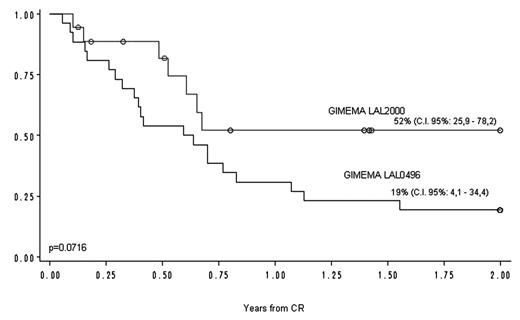Abstract
In the GIMEMA LAL 0496 trial, which has been conducted in Italy between 1996 and 2000, patients with adult ALL received an induction therapy with VCR, DNR and ASP until they reached complete remission (CR). Consolidation therapy with Ara-C and CTX was then administered and, if still in CR, patients received a 3-year maintenance therapy. Ph+ ALL patients were considered at high risk and after the induction phase a stem cell transplant (SCT) was planned, allogeneic for patients with an HLA identical sibling or autologous. A total of 498 patients have been enrolled by 50 GIMEMA Centers. Of these, 29 patients (5.8%) with either t(4;11) or t(1;19), who received the standard post-remissional approach, showed a statistically significant worse prognosis after CR: the projected probabilities of DFS and OS at 2 years were 19% (C.I. 95%: 4.1–34.4) and 31% (C.I. 95%: 14.2–47.9), respectively. Thus, in the new protocol - GIMEMA LAL 2000 - these patients received an intensive post-remissional treatment including SCT. Between 2000 and 2003, a total of 383 patients have been enrolled in this new protocol. Of these, 23 (6.0%) were positive either for t(4;11) or for t(1;19). The clinical characteristics of these patients are comparable to those of the patients enrolled in the previous study and the overall CR rate is also super imposable.
GIMEMA LAL 0496 vs GIMEMA LAL 2000
Fig. 1 shows the comparison in DFS at 2 years between LAL 0496 and LAL 2000; though not statistically significant, a trend towards a better prognosis is clearly seen. The DFS probability projected at 2 years is 52% (95% C.I. 26–78) compared to 19% (95% C.I. 4–35). The OS, projected at 2 years, is 42% (95% C.I. 14–70) compared to 31% (C.I. 95%: 14.2–47.9).
Despite the relatively limited case series, these results suggest that for t(4;11)+ and t(1;19)+ adult ALL intensification of the post-remissional treatment with SCT is a feasible approach that may improve the outcome in this subset of patients at high risk of relapse with standard post-remissional therapies.
Figure
| . | GIMEMA LAL 0496 . | GIMEMA LAL 2000 . | p . |
|---|---|---|---|
| Patients t(4;11) or t(1;19) | 29 | 23 | 0.7626 |
| Sex (M/F) | 14/15 | 8/15 | 0.3280 |
| Age yrs, median (min-max) | 37.8 (14.9–59.4) | 39.4 (19.6–59.2) | 0.1481 |
| WBC x 109/L median (min-max) | 41.2 (2.2–663.0) | 50.3 (2.4–300.0) | 0.9193 |
| Phenotype (B/T) | 29/0 | 23/0 | - |
| CR rate | 92.8% | 85.7% | 0.6392 |
| . | GIMEMA LAL 0496 . | GIMEMA LAL 2000 . | p . |
|---|---|---|---|
| Patients t(4;11) or t(1;19) | 29 | 23 | 0.7626 |
| Sex (M/F) | 14/15 | 8/15 | 0.3280 |
| Age yrs, median (min-max) | 37.8 (14.9–59.4) | 39.4 (19.6–59.2) | 0.1481 |
| WBC x 109/L median (min-max) | 41.2 (2.2–663.0) | 50.3 (2.4–300.0) | 0.9193 |
| Phenotype (B/T) | 29/0 | 23/0 | - |
| CR rate | 92.8% | 85.7% | 0.6392 |
Author notes
Corresponding author


This feature is available to Subscribers Only
Sign In or Create an Account Close Modal